#power bi business intelligence
Explore tagged Tumblr posts
Text
Unleash the potential of Microsoft Power Platform with us. We offer customized solutions, seamless integration, and dedicated support for your business needs.
#ms power platform#power platform#power apps#ms power platform consulting services#power bi#power automate#power bi business intelligence#power virtual agents#microsoft power platform#microsoft power apps#microsoft bi platform#microsoft no code platform#microsoft low code platform#power platform with NAV IT
0 notes
Text
#artificial intelligence#business#data analytics#datascience#power bi#sql#it services#information technology
4 notes
·
View notes
Text
Full Stack Developer vs. Front End Developer vs. Back End Developer
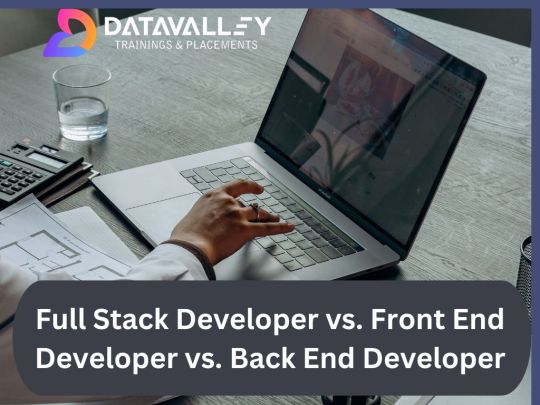
The role of a web developer is always included in the lists of high-paying IT jobs. This is because web developers are essential in today’s digital world. They create amazing websites, high-performing e-commerce sites, and other web-based applications. If you want to be a web developer, you must understand that full-stack developer skills are in great demand. However, do you understand the differences between full-stack, front-end, and back-end web development? In this post, we’ll see the differences between these three job roles, skills, and salaries.
What is Web Development?
The process of developing a website on the internet is known as web development. The non-design components of a website, such as building features and functioning with programming, markup, and scripting languages, are referred to as web development. Developers focus on technical aspects of website development such as architecture, programming, and application integration, as well as visuals.
A web developer is someone who does the following:
Creates and maintains webpages and other web-based applications.
Creates a website from a web design.
They collaborate with clients, stakeholders, and designers to understand the concept.
Can focus on frontend or backend development. Even as a full-stack developer, if necessary.
Types of Web Development
Front End Development: This aspect of web development focuses on what the user interacts with directly, i.e., the user interface of a website or web application. Front-end development deals with the design, layout, and interactivity of a site, ensuring that it’s visually appealing and user-friendly.
Back End Development: The back end is the part of a website or application that operates behind the scenes. It manages data, user authentication, and the server-side logic, ensuring the smooth functioning of the website.
Now, let’s delve into each of these roles in detail.
What is front-end development?
Front-end development, often referred to as client-side development, is the process of creating the visual elements of a website or web application that users interact with directly. It involves writing code for the user interface, optimizing website performance, and ensuring the site looks and functions correctly on various devices and browsers.
Who is a front-end developer?
A front-end developer, also known as a client-side developer, is responsible for turning web designs into a functioning website or application. They work closely with web designers and back-end developers to create an engaging and responsive user experience.
What are the front-end developer’s skills?
Front-end developers should be proficient in the following skills:
Mastery of HTML (Hypertext Markup Language) and CSS (Cascading Style Sheets) is fundamental for structuring and styling web pages.
Proficiency in JavaScript is crucial for adding interactivity and dynamic features to a website.
Knowledge of front-end frameworks like React, Angular, or Vue.js, which simplify and expedite development.
The ability to create websites that look and function well on various devices and screen sizes.
Ensuring that the website performs consistently across different browsers.
Familiarity with version control systems like Git for code management and collaboration.
Front End Developer Salary
The salary of a front-end developer can vary based on factors such as experience, location, and the company. On average, junior front-end developers can earn between $50,000 and $70,000 annually, while senior front-end developers can command salaries ranging from $90,000 to $120,000 or more.
What is Back End Development?
Back-end development, often referred to as server-side development, focuses on the server and database sides of a website or web application. It involves building and maintaining the server, databases, and applications that enable the front end to function correctly.
Who is a Back End Developer?
A back-end developer is responsible for managing the server, databases, and server-side logic of a website or application. They ensure that data is stored securely, accessed efficiently, and transmitted effectively between the front end and back end.
What are Back End Developer Skills?
Back-end developers should have expertise in the following areas:
Server-Side Programming Languages: Proficiency in languages such as Python, Ruby, Node.js, PHP, or Java is used to build server-side applications.
Databases: Knowledge of database management systems like MySQL, PostgreSQL, MongoDB, and NoSQL databases.
APIs: The ability to create and manage APIs (Application Programming Interfaces) for communication between the front end and back end.
Server Management: Skills in managing web servers and server infrastructure.
Security: Understanding web security practices and techniques to protect user data.
Version Control/Git: Proficiency in version control systems to manage and collaborate on code.
Back End Developer Salary
Back-end developer salaries can also vary based on experience, location, and the organization. Junior back-end developers can earn an annual salary ranging from $60,000 to $90,000, while senior back-end developers can expect salaries ranging from $100,000 to $150,000 or more.
Frontend vs. Backend Development
Front-end and back-end development are two halves of a whole, and they must work together seamlessly to create a functional website or application. While front-end developers focus on user interface and design, back-end developers deal with the underlying server infrastructure and data management. Both roles are essential for a successful web project.
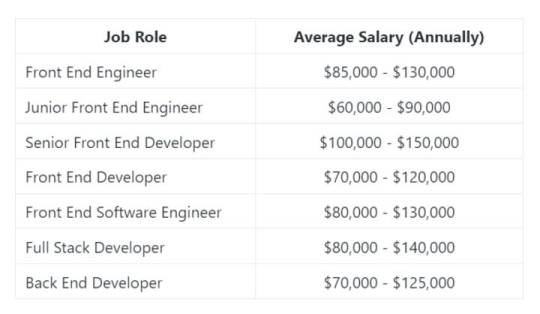
What is a Full Stack Developer?
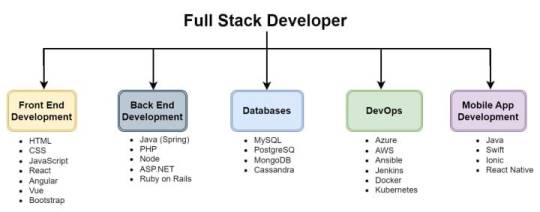
Who is a Full Stack Developer?
A full stack developer is a well-rounded professional who can take care of every aspect of web development, from designing the user interface to managing databases and server-side logic. They bridge the gap between front end and back-end development, ensuring that the entire application functions cohesively.
What are the Full Stack Developer Skills?
Full stack developers need a broad range of skills, including:
HTML/CSS: Proficiency in front end technologies for web page structuring and styling.
JavaScript: Mastery of JavaScript for creating dynamic and interactive web elements.
Front End Frameworks: Knowledge of front-end frameworks for efficient development.
Server-Side Programming Languages: Expertise in languages like Node.js, Python, Ruby, or Java for server-side development.
Databases: Proficiency in database management systems for data storage and retrieval.
APIs: Ability to create and manage APIs for communication between the front end and back end.
Version Control/Git: Familiarity with version control systems for code management.
Problem-Solving: Strong analytical and problem-solving skills to troubleshoot and optimize web applications.
Full Stack Developer Salary
Full-stack web developers are in high demand due to their range of skills and extensive knowledge. An average full stack developer’s annual salary might range from $110,000 to $150,000, based on their skill set and expertise.
Full-stack engineers earn more money than front end or back end developers. Employers agree to pay more for a full stack developer since it makes more business sense to hire one person with front and back end expertise rather than two.
As a result, the profession of a full stack developer is a profitable alternative for aspirants looking to create a career in the digital business.
The choice between becoming a full stack developer, front end developer, or back end developer depends on your interests, strengths, and career goals. Front end developers excel at creating visually appealing and user-friendly interfaces; back end developers focus on the server-side and data management; and full stack developers possess a comprehensive skill set that allows them to manage the entire development process. Each role is integral to the web development ecosystem, and the right one for you depends on your passions and aspirations within the field.
If you’re considering the path of a full stack developer and are eager to acquire the comprehensive skill set required to excel in this role, we have an excellent suggestion for you. Consider enrolling in the Full Stack Developer course at Datavalley.
Datavalley has a stellar track record of empowering aspiring developers with the knowledge and expertise to succeed in the dynamic world of web development. Their course covers everything from the fundamentals of HTML and CSS to in-depth training in JavaScript, front end and back end frameworks, and much more.
By joining Datavalley’s Full Stack Developer course, you’ll gain hands-on experience, build an impressive portfolio, and be well-prepared for a rewarding career in web development.
Don’t miss out on this opportunity to kickstart your journey as a Full Stack Developer with Datavalley. Your future in web development awaits. Take the first step today!
Attend Free Bootcamp at Datavalley
If you’re looking to supercharge your Java development skills and become a full-stack Java developer, consider joining the Java Full Stack Developer bootcamp at Datavalley. It’s an excellent opportunity to enhance your expertise and take your career to the next level.
Key points about Bootcamps:
It is completely free, and there is no obligation to complete the entire course.
20 hours total, two hours daily for two weeks.
Gain hands-on experience with tools and projects.
Explore and decide if the field or career is right for you.
Complete a mini project.
Earn a certificate to show on your profile.
No commitment is required after bootcamp.
Take another bootcamp if you are unsure about your track.
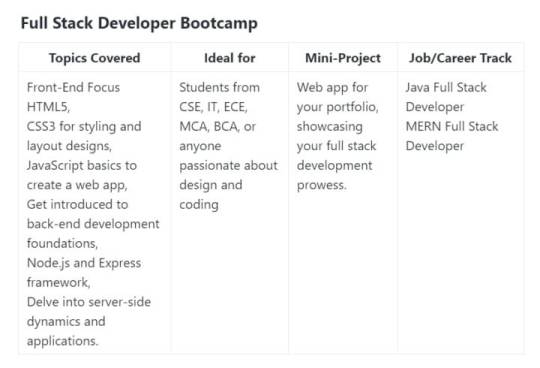
#datavalley#dataexperts#data engineering#data analytics#dataexcellence#business intelligence#data science#power bi#data analytics course#data science course#full stack course#full stack training#full stack web development#full stack developer#full stack software developer#front end developers#back end development
7 notes
·
View notes
Text
Ten business upgrades within your reach in 2024
Feeling behind the curve when it comes to leveraging data and technology in your business? Stuck relying on manual processes and gut instinct instead of actionable insights? You're not alone.
Tune into this special episode as hosts Rob and Justin reveal 10 achievable ways you can use data to transform your business in 2024. No fancy tech skills or big budgets required.
Learn how you can break free of Excel reporting, gain visibility across departments, and take the guesswork out of important decisions. Hear practical tips for unleashing marketing analytics, optimizing cloud investments, and even dipping your toe into AI.
We’ll also tackle ways to modernize budgeting and transform manual, offline processes to boost efficiency.
If you want to compete above your weight class in the year ahead, this episode is a must-listen. You’ll discover quick wins to drive profitability, service, and growth while creating capacity for the human strengths machines can’t match.
The tools to punch above your weight in 2024 are more accessible than ever. Tune in now to start planning your next plays.
Check out this episode!
2 notes
·
View notes
Text
Power BI Solution | Power BI Services

Power BI Solution is a highly effective tool that helps businesses make data-driven decisions. With its advanced analytics capabilities, this solution can transform raw data into actionable insights. Our Power BI Consulting services are designed to help businesses leverage the full potential of this solution and get the most out of their data. Our team of experts has years of experience in implementing and customizing Power BI solutions to suit the specific needs of businesses across various industries. With our help, businesses can unlock the full potential of Power BI and gain a competitive edge in today's data-driven world.
#Power BI consultant#Power BI Consulting services#Power BI Consulting Company#Power BI services#Power BI platform#Microsoft Power BI#BI Tool#BI solutions and services#business intelligence#business intelligence tool#Power BI
2 notes
·
View notes
Text
Top 10 Power BI Migration Best Practices: A Comprehensive Guide for 2025
Before focusing on specific Power BI migration best practices, it's important to know that successful migration requires careful planning and a well-structured approach. Our certified Power BI experts have gathered these best practices from years of experience and many successful projects.
Key Aspects of Power BI Migration Best Practices
Implementing Power BI migration best practices requires a comprehensive approach. Let's look at how these practices can improve your organization's data analytics capabilities.
1. Strategic Migration Planning and Architecture Design
Following Power BI migration best practices, a robust migration planning methodology is the cornerstone of any successful Power BI transition. The process begins with thoroughly assessing existing reports and dashboards and creating a detailed inventory of data sources and dependencies. Organizations should develop a phased migration approach while implementing proper version control implementation strategies to maintain consistency throughout the process.
2. Optimizing Data Models and Performance
Among critical Power BI migration best practices, data model optimization plays a crucial role in ensuring optimal performance post-migration. Implementing star schema design principles serves as the foundation for efficient data modeling. This should be combined with optimized relationships and cardinality, proper DAX optimization techniques, and efficient data refresh strategies to maintain peak performance.
3. Security and Compliance Framework
Modern Power BI migration best practices emphasize that robust security testing procedures are non-negotiable in today's data-driven landscape. This includes comprehensive row-level security implementation and properly configured authentication methods. Organizations must establish thorough audit logging setup procedures while ensuring all regulatory compliance measures are met and maintained throughout the migration process.
4. Infrastructure and Environmental Preparation
Following established Power BI migration best practices, proper infrastructure preparation ensures a stable foundation for your Power BI environment. This encompasses configuring data gateways and implementing load-balancing setup mechanisms. Organizations must establish comprehensive capacity planning guidelines and resource allocation planning to support their growing data needs.
5. User Management and Access Control
Contemporary Power BI migration best practices stress that effective user access migration requires careful consideration of various aspects of security and accessibility. This includes implementing role assignment strategies and setting up workspace access control mechanisms. The management of permission inheritance and establishment of robust identity management protocols ensure secure and efficient user access management.
6. Testing and Validation Protocols
Comprehensive migration testing methods are essential for ensuring reliability and performance. This includes conducting thorough integration testing and detailed user acceptance testing. Implementing quality assurance protocols helps maintain data accuracy and consistency throughout the migration process.
7. Documentation and Knowledge Transfer
Creating detailed migration documentation is fundamental for long-term success. This encompasses developing comprehensive user training materials and establishing standard operating procedures. Technical teams should maintain detailed technical specifications and troubleshooting documentation for future reference and support.
8. System Integration and Connectivity
Successful API integration forms the backbone of seamless operation in a Power BI environment. This includes managing system connectivity and implementing custom connector migration procedures. Organizations must ensure cross-platform compatibility and proper service integration to maintain smooth operations.
9. Monitoring and Maintenance Strategy
Implementing effective post-migration monitoring ensures sustained performance and reliability. This involves setting up comprehensive performance analytics and configuring appropriate alert configuration systems. Organizations should establish robust backup procedures and implement thorough health metrics tracking for ongoing maintenance.
10. Cloud Integration and Management
Proper cloud resource management is crucial for modern deployments in today's digital landscape. This includes seamless Azure integration and implementation of robust cloud security setup protocols. Organizations must establish comprehensive disaster recovery protocols and maintain efficient tenant configuration management.
Why Choose DataTerrain for Your Power BI Migration
At DataTerrain, we understand that implementing Power BI migration best practices requires expertise, experience, and a proven methodology. Our team of certified professionals has successfully guided numerous organizations through their Power BI migration journey, ensuring optimal performance, security, and user adoption.
DataTerrain stands out in the industry with over 15 years of data analytics expertise backed by certified Power BI professionals who understand the nuances of successful migrations. Our proven migration methodology, comprehensive support and training, and custom solutions are tailored to meet your organizational needs.
0 notes
Text
AI Agents: Shaping the Future of Industries and Businesses

Understanding AI Agents
AI Agents are sophisticated software entities that leverage machine learning, natural language processing (NLP), and advanced analytics to perform tasks. Unlike traditional software, which follows predetermined rules, AI Agents learn and adapt to changing scenarios. They can analyze massive datasets, extract actionable insights, and execute decisions in real time.
Their applications are diverse. In retail, AI Agents are optimizing supply chains and personalizing customer interactions. In healthcare, they are assisting in diagnostics and treatment recommendations. Financial services leverage AI Agents to detect fraud and improve risk management. The potential of AI Agents is virtually limitless, making them a cornerstone of the digital future.
Industry Impact: Current Trends and Applications
AI Agents are reshaping industries in the following ways:
Retail and E-commerce:
Personalized recommendations enhance customer experiences.
Inventory management and demand forecasting are becoming more efficient.
Virtual assistants are improving post-purchase support.
Healthcare:
AI Agents are expediting drug discovery processes.
Virtual health assistants support patient care by offering 24/7 assistance.
Predictive analytics improves patient outcomes by identifying potential health risks early.
Finance and Banking:
Intelligent agents are streamlining customer service via chatbots and virtual assistants.
Fraud detection systems powered by AI are becoming more accurate and responsive.
Portfolio management is evolving with AI-driven insights.
Manufacturing:
Predictive maintenance powered by AI Agents reduces downtime and improves operational efficiency.
Quality control processes are becoming more precise and automated.
Supply chain management is optimized for cost and time efficiency.
Energy and Utilities:
AI Agents are enabling smarter energy grids by balancing supply and demand.
Predictive analytics ensures efficient energy usage and reduced waste.
Renewable energy projects are being optimized with AI-driven simulations.
The Future of AI Agents: What Lies Ahead?��
As industries continue to digitize, the role of AI Agents will expand. Here’s what the future holds:

Integration of Generative AI: AI Agents will harness the power of generative AI to create content, design products, and innovate solutions. This capability will redefine industries like marketing, entertainment, and education.
Integration of Generative AI: AI Agents will harness the power of generative AI to create content, design products, and innovate solutions. This capability will redefine industries like marketing, entertainment, and education.
Enhanced Decision-Making: With access to real-time data and advanced analytics, AI Agents will enable businesses to make faster and more accurate decisions. This will drive agility and competitiveness across sectors.
Unifying Data Silos: As organizations struggle with fragmented data sources, AI Agents will serve as the bridge, integrating disparate datasets to create a unified view. This will enhance collaboration and efficiency.
Compliance and Ethics: The deployment of AI Agents will come with increased focus on ethical considerations and regulatory compliance. AI systems will be designed to ensure transparency and accountability, building trust in AI-driven ecosystems.
AI Agents as a Service (IaaS): The concept of “Intelligent as a Service” will gain traction, where AI Agents are offered as scalable, subscription-based solutions. This will democratize access to AI, enabling small and medium enterprises to leverage cutting-edge technology without substantial upfront investment.
How PreludeSys is Paving the Way
At PreludeSys, we understand that the future of industries lies in leveraging AI to its fullest potential. As a Microsoft featured partner specializing in data modernization services, data and AI services, and business intelligence solutions, we are uniquely positioned to help businesses harness the power of AI Agents.
Our expertise spans the end-to-end lifecycle of AI implementation, from data platform modernization to the development and deployment of intelligent systems. As a trusted data modernization consulting company, we help organizations:
Centralize and Modernize Data: By integrating platforms like Microsoft Fabric and Dataverse, we enable businesses to create a unified data foundation.
Enhance Decision-Making: With advanced analytics and AI-driven insights, we empower organizations to make informed choices.
Improve Operational Efficiency: By deploying AI Agents tailored to industry-specific needs, we streamline processes and drive cost savings.
Prepare for the Future: Our AI and machine learning solutions lay the groundwork for next-generation technologies, ensuring scalability and adaptability.
By embracing AI Agents and partnering with experts like PreludeSys, organizations can position themselves at the forefront of this transformation, ensuring long-term growth and sustainability.
Why Partner with PreludeSys?
With a proven track record of delivering transformative solutions, we bring deep industry knowledge and technical expertise to every engagement. Our collaborative approach ensures that our clients achieve tangible business outcomes while staying ahead in an ever-evolving digital landscape.
Whether it’s modernizing your data infrastructure, deploying AI-powered tools, or exploring the potential of AI Agents, PreludeSys is your trusted partner for success in the data-driven era.
#ai agent#Artificial intelligence as a service#business intelligence#business intelligence services#business intelligence consulting services#power bi services
0 notes
Text
The Future of Data Analytics: Emerging Trends in Power BI
In the ever-evolving landscape of data analytics, Power BI continues to lead the charge with cutting-edge innovations that empower businesses to make data-driven decisions. As organizations increasingly rely on analytics to stay competitive, understanding the emerging trends in Power BI becomes essential for leveraging its full potential.
Here’s a look at what the future holds for Power BI and how these trends can revolutionize data analytics.
AI-Driven Insights
Artificial Intelligence (AI) is reshaping data analytics, and Power BI is at the forefront of this transformation. Features like AI-powered visualizations and natural language processing (NLP) allow users to interact with their data intuitively.
With tools like Quick Insights and AI Builder, businesses can uncover hidden patterns and predict trends, enabling smarter decision-making. The integration of AI makes it easier than ever for users to derive actionable insights without extensive technical expertise.
Real-Time Data Analytics
The demand for real-time insights is surging as businesses seek to make quicker decisions. Power BI’s real-time dashboards and streaming data capabilities provide up-to-the-second updates, enabling organizations to monitor key metrics and respond proactively.
This trend is especially crucial for industries like retail, finance, and healthcare, where timely decisions can have a significant impact.
Enhanced Integration with Third-Party Tools
Power BI’s seamless integration with tools like Microsoft Excel, Azure, and third-party applications is becoming even more robust. As businesses work with diverse data sources, enhanced integration ensures a unified view of their data ecosystem. This capability streamlines workflows, reduces silos, and fosters better collaboration across teams.
Custom Visualizations and Reports
Tailored insights are becoming a necessity for organizations aiming to address specific business needs. Power BI’s customization capabilities allow users to create bespoke dashboards and reports, ensuring that analytics align with unique goals. This trend reflects the growing importance of personalized solutions in today’s data-driven world.
Growing Adoption of Mobile Analytics
With remote work and mobile operations on the rise, Power BI’s mobile app is gaining traction. Users can access and interact with dashboards from anywhere, ensuring that decision-makers remain informed and agile, regardless of location.
Power BI continues to evolve, offering businesses unparalleled capabilities in data visualization, real-time monitoring, and AI-driven analytics. By staying ahead of these emerging trends, organizations can harness the full potential of Power BI to drive growth and innovation. For more details reach out power bi solutions.
#power bi integration#power bi solutions#data visualization#data analysis#data science course#data science#machine learning#business intelligence
0 notes
Text
Will Power BI Work on a Mac? Exploring Compatibility and Alternatives
If you're a Mac user interested in using Power BI, you might be wondering about its compatibility with macOS. Unfortunately, Microsoft Power BI Desktop is not natively supported on Mac systems. However, there are several workarounds that enable you to access this powerful business intelligence tool on your Mac.
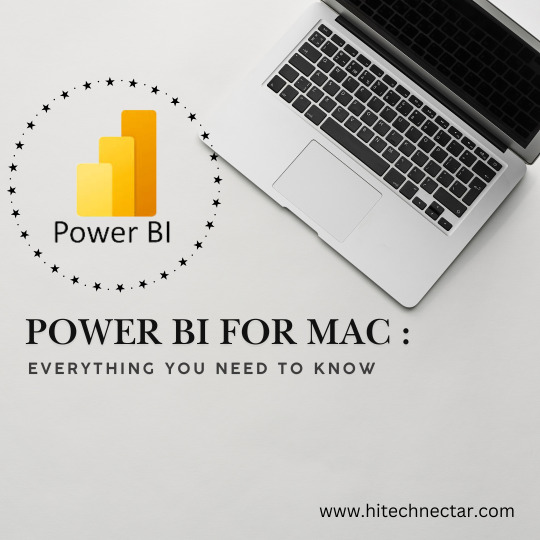
Here’s a quick overview of your options:
Use Power BI Service via Web Browser The simplest way to use Power BI on a Mac is through the Power BI Service, which is accessible via any modern web browser. Just sign up for an account, and you can create reports and dashboards directly online without needing any additional software.
Run Power BI on a Virtual Machine You can install Windows on your Mac using virtualization software like Parallels Desktop or VMware Fusion. This allows you to run Windows applications, including Power BI Desktop, seamlessly alongside macOS.
Boot Camp Apple's Boot Camp Assistant lets you install Windows on your Mac, enabling you to switch between macOS and Windows. This method provides better performance since it runs Windows natively on your hardware.
Remote Access to a Windows PC If you have access to a Windows PC, you can install Power BI there and use remote desktop applications like Microsoft Remote Desktop, TeamViewer, or AnyDesk to access it from your Mac.
Consider Alternatives If these options seem cumbersome, you might explore alternative business intelligence tools that are compatible with macOS, such as Holistics or Looker, which offer similar functionalities without the need for Windows.
In conclusion, while Power BI does not directly support macOS, these alternatives allow you to leverage its capabilities effectively. Whether through web access or running Windows on your Mac, you can still harness the power of Power BI for your data analysis needs!
0 notes
Text

How Power BI and OLAP Cubes Improve Your Business
Learn how Power BI and OLAP cubes enhance business intelligence by providing robust data analysis, interactive reporting, and improved decision-making for better business outcomes. This is where tools such as Power BI and OLAP cubes become handy, changing how organizations analyze data.
1 note
·
View note
Text
The Future of Full Stack Java Development
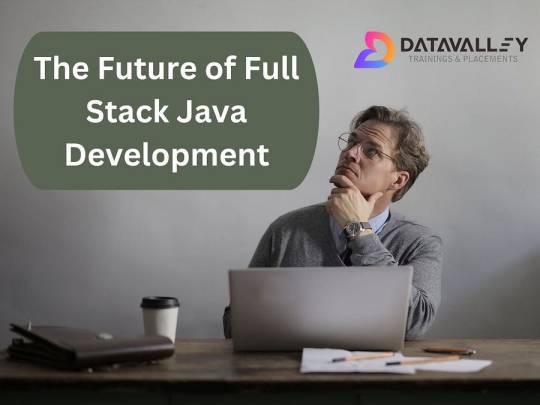
Full-stack developers, also known as “jack of all trades,” are in high demand in India. They are capable of carrying out the duties of numerous professionals. They earn good money and have many job opportunities with rewarding experiences because of their diverse skills. Full-stack Java programming has a bright future because its popularity is growing and will continue to grow in the coming years.
It’s well known that full-stack developers are proficient in both server-side and client-side programming. They are the professionals who carry out the responsibilities of backend and frontend developers. Despite not always being regarded as specialists, their abilities enable them to handle development tasks with ease. All firms look forward to having a brilliant full-stack developer as a future developer for a number of reasons. They handle a variety of technologies, which enables them to manage more project facets than the typical coder.
An experienced web developer who primarily works with Java programming is known as a Java full-stack developer. The front end, back end, and database layer are the three levels of code that these web developers build. The web development teams are frequently led by full-stack Java engineers, who also assist in updating and designing new websites. Because there is a great demand for Java full-stack developers. Many institutions have seized the opportunity by providing well-thought-out Java full-stack developer courses. You may study full-stack development quickly and become an expert in the area with the aid of these courses.
Java Full Stack Development by Datavalley
100% Placement Assistance
Duration: 3 Months (500+ hours)
Mode: Online/Offline
Let’s look into the future opportunities for full-stack Java professionals in India.
4 things that will Expand the Future Purpose of Java Full-Stack Developers
The Role of a Full-Stack Developer
Full-stack developers work on numerous tasks at once. They need to be extremely talented and knowledgeable in both front-end and back-end programming languages for this. JavaScript, CSS, HTML, and other frontend programming languages are essential. When creating new websites or modifying old ones, Java is a key programming language used by Java full-stack developers. However, backend programming languages consist of .Net, PHP, and Python depending on the projects. The full stack developers are distinguished from other developers by their proficiency and understanding of programming languages. With the availability of the finest Java full stack developer training, students may now easily master a frontend programming language like Java. The full-stack developer is more valuable and in demand when they are knowledgeable in multiple programming languages.
Responsibilities of a Full-Stack Developer
Functional databases are developed by full-stack developers. It creates aesthetically pleasing frontend designs that improve user experience and support the backend. The entire web-to-web architecture is under the control of these full-stack developers. They are also in charge of consistently maintaining and updating the software as needed. The full-stack developers bear the responsibility of overseeing a software project from its inception to its finalized product.
In the end, these full-stack developers also satisfy client and technical needs. Therefore, having a single, adaptable person do many tasks puts them in high demand and increases their potential for success in the technology field. Through extensively developed modules that expand their future scope, the Java full-stack developer course equips students with the skills necessary to take on these tasks.
The full-stack developer salary range
Full-stack developers are among the highest-paid workers in the software industry. In India, the average salary for a full-stack developer is 9.5 lakhs per annum. The elements that determine income typically include experience, location of the position, company strength, and other considerations. A highly skilled and adaptable full-stack developer makes between 16 and 20 lakhs per annum. Full-stack engineers get paid a lot because of their extensive skills, they can handle the tasks of two or three other developers at once.
By fostering the growth of small teams, preventing misunderstandings, and cutting the brand’s operating expenses, these full-stack developers perform remarkable work. Students who take the Java full-stack developer course are better equipped to become versatile full-stack developers, which will increase their demand currently as well as in the future in the industry.
Job Opportunities of Java Full Stack Developers
The full-stack developers are knowledgeable professionals with a wide range of technological skills. These competent workers are conversant with numerous stacks, including MEAN and LAMP, and are capable of handling more tasks than a typical developer. They are skilled experts with a wealth of opportunities due to their extensive understanding of several programming languages.
Full-stack developers are in high demand because they can work on a variety of projects and meet the needs of many companies. The full-stack Java developer course helps students build this adaptability so they can eventually become the first choice for brands searching for high-end developers.
As a result, these are a few key factors improving the future prospects of Java Full Stack developers in India. They are vibrant professionals who are in high demand due to their diverse skill set and experience, and they are growing steadily. The Java full stack developer course can help students hone their knowledge and abilities to succeed in this industry.
Datavalley’s Full Stack Java Developer course can help you start a promising career in full stack development. Enroll today to gain the expertise and knowledge you need to succeed.
Attend Free Bootcamps
Looking to supercharge your Java skills and become a full-stack Java developer? Look no further than Datavalley’s Java Full Stack Developer bootcamp. This is your chance to take your career to the next level by enhancing your expertise.
Key points about Bootcamps:
It is completely free, and there is no obligation to complete the entire course.
20 hours total, two hours daily for two weeks.
Gain hands-on experience with tools and projects.
Explore and decide if the field or career is right for you.
Complete a mini-project.
Earn a certificate to show on your profile.
No commitment is required after bootcamp.
Take another bootcamp if you are unsure about your track.

#dataexperts#datavalley#data engineering#data analytics#dataexcellence#business intelligence#data science#power bi#data analytics course#data science course#java developers#java full stack bootcamp#java full stack training#java full stack course#java full stack developer
2 notes
·
View notes
Text
Only Amateurs Name Drop Steve Ballmer, w/ Mike Nichols
Get ready for an exciting episode of Raw Data by P3 Adaptive! Our guest today is Mike Nichols, a consumer technology and entertainment leader with a proven track record of building growth businesses and exceptional organizations. He's none other than the former Chief Marketing Officer at Xbox, who played a critical role in turning around the Xbox One release with his customer-centric and innovative marketing campaigns featuring #AaronPaul and #DannyMcBride. But that's not all—our guest also had a significant impact on the development of Microsoft's search engine, Bing, which was originally launched as Microsoft Live.
Mike also shares his data journey and some inside information on how he brings people together to drive growth and build iconic brands. He shares his insights on customer-centricity, innovation, diversity, and teamwork, and how these principles have guided his leadership throughout his career. From Xbox to Bing, our guest has left a lasting impact on the tech industry, and as a bonus, we even get to learn the truth about what "BING" stands for and what Mike knows about the naming process.
It's not all facts today, though, we do get a little speculation as Rob, Mike, and Tom delve into a fascinating debate about the divorce rate at Microsoft. Tom proposes a theory on the durability of first marriages for the first generation of Microsoft employees, and Rob and Mike weigh in on whether the overall rate is higher than the general public's and, more importantly, whether the rate is higher for Microsoft employees who were closely associated with Rob Collie. Is it the Microsoft Effect or the Rob Collie Effect? Regardless, this interesting discussion sheds light on the impact of work culture on personal relationships and the challenges of maintaining a healthy work-life balance in the tech industry.
Join us for an episode that is both entertaining and thought-provoking, as we explore the people behind the tech and the impact of work culture on personal relationships. This is an episode you won't want to miss!
And, as always, if you enjoyed this episode, be sure to leave us a review on your favorite podcast platform to help new users find us.
Also on this episode:
Windows live search – Bing
The Software Hall of Fame, w/ Microsoft's Conor Cunningham
Microsoft Team Manager
Asana
Needle Nose Ned
Happy Families are all alike: Anna Karenina
Aaron Paul Xbox Commercial
Danny McBride: More is Better Xbox commercial
Bada-Bing: Sopranos
DOJ v Microsoft: Antitrust Case summary
Malcolm Butler Game Winning Interception! Super Bowl XLIX
Anchorman 2: News Team Fighting Words Scene
Check out this episode!
2 notes
·
View notes
Text
Jatan Shah Reviews | 2-Day Power BI Workshop
What I Will Teach You In This 2-Day Power BI Workshop Will Not Just Help You Master Business Intelligence, But Also Help You Scale Any Business By Leveraging The Power Of Data. It’s all possible by creating your own Artificially Intelligent Dashboards!!
#Power BI Workshop#Artificially Intelligent Dashboards#Master Business Intelligence#jatan shah#jatan shah reviews#jatan shah skill nation reviews#jatan shah skill nation#skill nation reviews#skill nation student reviews
0 notes
Text
Unlock the Power of Data with My Free Power BI & Microsoft Fabric Pricing Estimator! 🚀
Starting your journey with Power BI or Microsoft Fabric can feel overwhelming, especially if you're new to these powerful tools. From mastering the features to navigating configurations, determining the right licenses and understanding potential costs can add to the confusion. That's why I'm excited to introduce our brand-new, free-to-use Power BI & Microsoft Fabric Pricing Estimator! At Easy Insight, I helped create this tool to simplify your licensing decisions, demystifying the complexities so you can focus on what truly matters—leveraging your data effectively.
The Complexity of Power BI & Microsoft Fabric Pricing
Let’s face it—Microsoft Power BI is incredible for data visualization and business intelligence, and Microsoft Fabric takes it even further with advanced analytics. However, all these fantastic features come with a complex pricing structure. Here’s why it can be so tricky:
Multiple Subscription Plans: With options like Power BI Pro, Power BI Premium per User, and now Microsoft Fabric replacing Power BI Premium Capacity (distinct from Premium per User), each comes with its own pricing model.
Different User Types and Licensing: Not every team member needs the same license, adding another layer of complexity.
Data Volume and Features: Whether you need Co-Pilot, Data Lakehouse, more storage, or frequent data refreshes (up to 48 times a day), these factors significantly impact your licensing needs.
Regional Pricing: Costs can vary based on your business location, complicating things for global teams.
All these elements make it challenging to get a clear picture of your expected expenses, especially when planning for growth or working within a tight budget.
Introducing My New Power BI & Microsoft Fabric Pricing Estimator
To tackle these challenges, I developed the Power BI & Microsoft Fabric Pricing Estimator. This tool offers a transparent and personalized cost estimate, guiding you step-by-step through a few simple questions to understand your business needs better. Whether you’re a small business starting with Power BI or a large enterprise exploring Microsoft Fabric’s advanced features, our estimator adapts to your specific requirements, ensuring you know exactly where your money is going.
See how the Power BI/Microsoft Fabric Cost Calculator can help you find the best pricing and license options for your business.
How the Pricing Estimator Works
Using our Pricing Estimator is incredibly simple and only takes a few clicks. Here’s how it works:
Enter Your Organisation’s Details:
Number of Users: Specify how many people need access and the type of licenses they require (e.g., Power BI Pro, Premium).
Data Usage: Estimate your data consumption to ensure you have the right storage and processing capabilities.
Licensing Preferences: Choose between different licensing options like Pay-As-You-Go or committing to a 12-month plan.
Regional Preferences: Select your operating region (e.g., UK or US) to account for any regional pricing differences.
Generate Your Estimate:
Once you provide your details, the estimator crunches the numbers and delivers a detailed breakdown of your expected monthly and yearly costs.
Review and Adjust:
Examine your estimate and tweak the inputs to explore different scenarios or optimize your budget further.
It’s that simple! Answer a few questions, and I’ll provide you with our licensing recommendations and associated costs.
Current Coverage & Future Expansions
Currently, our Pricing Estimator covers US and UK pricing. I'm continuously working to expand our tool to include more regions, and I need your help! Let me know in the comments which regions you'd like us to add next. Your feedback is invaluable in ensuring our tool meets the needs of businesses like yours around the globe. Together, we can make the Pricing Estimator even more comprehensive and useful for everyone.
Get Started Today: Try the Pricing Estimator
Don’t let licensing complexities hold your organization back from harnessing the full potential of Power BI and Microsoft Fabric. Our Power BI & Microsoft Fabric Pricing Estimator is here to help you make strategic, informed decisions that align with your business intelligence needs. Here’s how to get started:
Visit Our Pricing Estimator Page: Access the tool here.
Enter Your Details: Provide necessary information about your organization’s users, data usage, licensing preferences, and region.
Review Your Estimate: Receive a detailed cost breakdown and explore different licensing scenarios to find the best fit for your budget.
Take Action: Use the information to kickstart your Power BI/Fabric journey, or reach out to our team for further assistance.
Empower Your Business Intelligence Journey
I hope our Power BI & Microsoft Fabric Pricing Estimator equips you with the tools and knowledge needed to make informed, cost-effective licensing decisions. By simplifying the complexities of licensing and pricing, I aim to empower more businesses to take their first step with these invaluable BI tools.
Ready to take the next step? Try our Pricing Estimator today, and remember, if you need personalized support or guidance, the Easy Insight team is here to help!
Frequently Asked Questions (FAQ)
Do I need to sign up for a newsletter or marketing updates to use the Pricing Estimator?
Nope! You can use our Power BI & Microsoft Fabric Pricing Estimator without signing up for any newsletters or marketing communications. However, if you’re interested in staying updated with the latest tips, updates, and exclusive offers from Easy Insight, you’re always welcome to subscribe!
Will you keep or store my data after I use the estimator?
Your privacy is important to us. We do not store any of the data you input into the Pricing Estimator. Once you receive your estimate, all the information you provided is securely deleted from our servers.
Is the Pricing Estimator free to use?
Yes, absolutely! Our Pricing Estimator is completely free to use with no hidden fees or charges—just straightforward, accurate cost estimates tailored to your needs.
Can I get support if I have questions while using the estimator?
Of course! If you have any issues or questions while using the Pricing Estimator, feel free to reach out to our team at Easy Insight. We’re here to help you every step of the way.
When will you add pricing for regions outside the US and UK?
I’m actively working on expanding our Pricing Estimator to include more regions. Let me know in the comments which regions you'd like us to add next, and I’ll prioritize them in future updates.
How often is the pricing information updated in the estimator?
I regularly review and update our Pricing Estimator to ensure accuracy, reflecting any changes in subscription plans, regional pricing, or feature add-ons. You can trust that the estimates you receive are based on the most current data available.
What if my licensing needs change after I use the estimator?
Licensing needs can evolve as your business grows or changes. Simply revisit the tool and update your inputs to get a new estimate. Additionally, our team at Easy Insight is always here to help you reassess and optimize your licensing as needed.
1 note
·
View note
Text
My Journey in Learning Power BI: Crafting Visually Appealing Dashboards for My Services and Clients
Introduction As an IT consultant at Valantic Hamburg, I focus primarily on developing Chatbots using platforms like Cognigy, IBM Watson Assistant, and Discovery. Throughout my experience, I have recognized the importance of effectively communicating the usage data of my clients’ customers who interact with these Chatbots. This realization led me to explore Microsoft Power BI, a tool that allows…
#Business Intelligence#Chatbots#Cognigy#Dashboard Design#Data Analysis#Data Analytics#Data Visualization#IBM Watson Assistant#IT Consulting#Microsoft Power BI#PL-300 Exam#Power BI
0 notes
Text
Ivo Everts, Databricks: Enhancing open-source AI and improving data governance
New Post has been published on https://thedigitalinsider.com/ivo-everts-databricks-enhancing-open-source-ai-and-improving-data-governance/
Ivo Everts, Databricks: Enhancing open-source AI and improving data governance
.pp-multiple-authors-boxes-wrapper display:none; img width:100%;
Ahead of AI & Big Data Expo Europe, AI News caught up with Ivo Everts, Senior Solutions Architect at Databricks, to discuss several key developments set to shape the future of open-source AI and data governance.
One of Databricks’ notable achievements is the DBRX model, which set a new standard for open large language models (LLMs).
“Upon release, DBRX outperformed all other leading open models on standard benchmarks and has up to 2x faster inference than models like Llama2-70B,” Everts explains. “It was trained more efficiently due to a variety of technological advances.
“From a quality standpoint, we believe that DBRX is one of the best open-source models out there and when we refer to ‘best’ this means a wide range of industry benchmarks, including language understanding (MMLU), Programming (HumanEval), and Math (GSM8K).”
The open-source AI model aims to “democratise the training of custom LLMs beyond a small handful of model providers and show organisations that they can train world-class LLMs on their data in a cost-effective way.”
In line with their commitment to open ecosystems, Databricks has also open-sourced Unity Catalog.
“Open-sourcing Unity Catalog enhances its adoption across cloud platforms (e.g., AWS, Azure) and on-premise infrastructures,” Everts notes. “This flexibility allows organisations to uniformly apply data governance policies regardless of where the data is stored or processed.”
Unity Catalog addresses the challenges of data sprawl and inconsistent access controls through various features:
Centralised data access management: “Unity Catalog centralises the governance of data assets, allowing organisations to manage access controls in a unified manner,” Everts states.
Role-Based Access Control (RBAC): According to Everts, Unity Catalog “implements Role-Based Access Control (RBAC), allowing organisations to assign roles and permissions based on user profiles.”
Data lineage and auditing: This feature “helps organisations monitor data usage and dependencies, making it easier to identify and eliminate redundant or outdated data,” Everts explains. He adds that it also “logs all data access and changes, providing a detailed audit trail to ensure compliance with data security policies.”
Cross-cloud and hybrid support: Everts points out that Unity Catalog “is designed to manage data governance in multi-cloud and hybrid environments” and “ensures that data is governed uniformly, regardless of where it resides.”
The company has introduced Databricks AI/BI, a new business intelligence product that leverages generative AI to enhance data exploration and visualisation. Everts believes that “a truly intelligent BI solution needs to understand the unique semantics and nuances of a business to effectively answer questions for business users.”
The AI/BI system includes two key components:
Dashboards: Everts describes this as “an AI-powered, low-code interface for creating and distributing fast, interactive dashboards.” These include “standard BI features like visualisations, cross-filtering, and periodic reports without needing additional management services.”
Genie: Everts explains this as “a conversational interface for addressing ad-hoc and follow-up questions through natural language.” He adds that it “learns from underlying data to generate adaptive visualisations and suggestions in response to user queries, improving over time through feedback and offering tools for analysts to refine its outputs.”
Everts states that Databricks AI/BI is designed to provide “a deep understanding of your data’s semantics, enabling self-service data analysis for everyone in an organisation.” He notes it’s powered by “a compound AI system that continuously learns from usage across an organisation’s entire data stack, including ETL pipelines, lineage, and other queries.”
Databricks also unveiled Mosaic AI, which Everts describes as “a comprehensive platform for building, deploying, and managing machine learning and generative AI applications, integrating enterprise data for enhanced performance and governance.”
Mosaic AI offers several key components, which Everts outlines:
Unified tooling: Provides “tools for building, deploying, evaluating, and governing AI and ML solutions, supporting predictive models and generative AI applications.”
Generative AI patterns: “Supports prompt engineering, retrieval augmented generation (RAG), fine-tuning, and pre-training, offering flexibility as business needs evolve.”
Centralised model management: “Model Serving allows for centralised deployment, governance, and querying of AI models, including custom ML models and foundation models.”
Monitoring and governance: “Lakehouse Monitoring and Unity Catalog ensure comprehensive monitoring, governance, and lineage tracking across the AI lifecycle.”
Cost-effective custom LLMs: “Enables training and serving custom large language models at significantly lower costs, tailored to specific organisational domains.”
Everts highlights that Mosaic AI’s approach to fine-tuning and customising foundation models includes unique features like “fast startup times” by “utilising in-cluster base model caching,” “live prompt evaluation” where users can “track how the model’s responses change throughout the training process,” and support for “custom pre-trained checkpoints.”
At the heart of these innovations lies the Data Intelligence Platform, which Everts says “transforms data management by using AI models to gain deep insights into the semantics of enterprise data.” The platform combines features of data lakes and data warehouses, utilises Delta Lake technology for real-time data processing, and incorporates Delta Sharing for secure data exchange across organisational boundaries.
Everts explains that the Data Intelligence Platform plays a crucial role in supporting new AI and data-sharing initiatives by providing:
A unified data and AI platform that “combines the features of data lakes and data warehouses into a single architecture.”
Delta Lake for real-time data processing, ensuring “reliable data governance, ACID transactions, and real-time data processing.”
Collaboration and data sharing via Delta Sharing, enabling “secure and open data sharing across organisational boundaries.”
Integrated support for machine learning and AI model development with popular libraries like MLflow, PyTorch, and TensorFlow.
Scalability and performance through its cloud-native architecture and the Photon engine, “an optimised query execution engine.”
As a key sponsor of AI & Big Data Expo Europe, Databricks plans to showcase their open-source AI and data governance solutions during the event.
“At our stand, we will also showcase how to create and deploy – with Lakehouse apps – a custom GenAI app from scratch using open-source models from Hugging Face and data from Unity Catalog,” says Everts.
“With our GenAI app you can generate your own cartoon picture, all running on the Data Intelligence Platform.”
Databricks will be sharing more of their expertise at this year’s AI & Big Data Expo Europe. Swing by Databricks’ booth at stand #280 to hear more about open AI and improving data governance.
Explore other upcoming enterprise technology events and webinars powered by TechForge here.
Tags: ai, ai expo, artificial intelligence, data intelligence platform, databricks, dbrx, ivo everts, large language models, llm, mosaic ai, open source, open-source, unity catalog
#access control#access management#adoption#ai#ai & big data expo#ai expo#ai model#AI models#ai news#ai platform#AI-powered#amp#Analysis#app#applications#approach#apps#architecture#Articles#artificial#Artificial Intelligence#assets#audit#AWS#azure#benchmarks#bi#Big Data#Building#Business
0 notes